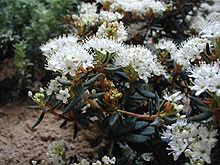- Rhododendron tomentosum
-
Marsh Labrador tea R. tomentosum in flower Scientific classification Kingdom: Plantae (unranked): Angiosperms (unranked): Eudicots (unranked): Asterids Order: Ericales Family: Ericaceae Genus: Rhododendron Species: R. tomentosum Binomial name Rhododendron tomentosum
HarmajaSynonyms Ledum palustre
Rhododendron tomentosum (syn. Ledum palustre), commonly known as Marsh Labrador tea, northern Labrador tea or wild rosemary, is a flowering plant in the subsection Ledum of the large genus Rhododendron in the family Ericaceae.
Contents
Growth
It is a low shrub growing to 50 cm (rarely up to 120 cm) tall with evergreen leaves 12-50 mm long and 2-12 mm broad. The flowers are small, with a five-lobed white corolla, and produced several together in a corymb 3-5 cm diameter. They emit strong smell to attract bees and other pollinating insects.
Habitat
In North America it is found growing in northern latitudes in Greenland, Canada, and Alaska, in Europe in the northern and central parts, and in Asia south to northern China, Korea and Japan. It grows in peaty soils, shrubby areas, moss and lichen tundra.
Chemical compounds
All parts of the plant contain poisonous terpenes that affect the central nervous system. First symptoms of overdose are dizziness and disturbances in movement, followed by spasms, nausea, and unconsciousness. The mere smell of the plant may cause headache to some people.
Species
This species is not to be confused with the traditionally-used one Rhododendron groenlandicum, found particularly in the Labrador region (where its name comes from) and also throughout the rest of Northern North America.
Uses
Medicinal uses
For traditional uses in herbal medicine, see Labrador tea.
This is considered to be a homeopathic agent. This is a specific remedy for puncture wounds produced by sharp-pointed objects or bites.
Other uses
Marsh Labrador tea has traditionally been used as a gruit in brewing beer in the Middle Ages. Due to its strong fragrance, it has also formerly been used as a natural anti-moth (for Clothing Moth) in Scandinavia.
External links and references
Categories:- Rhododendron
- Herbal tea
- Medicinal plants
- Flora of Japan
- Flora of Korea
- Flora of Norway
- Flora of Germany
- Flora of Russia
Wikimedia Foundation. 2010.

